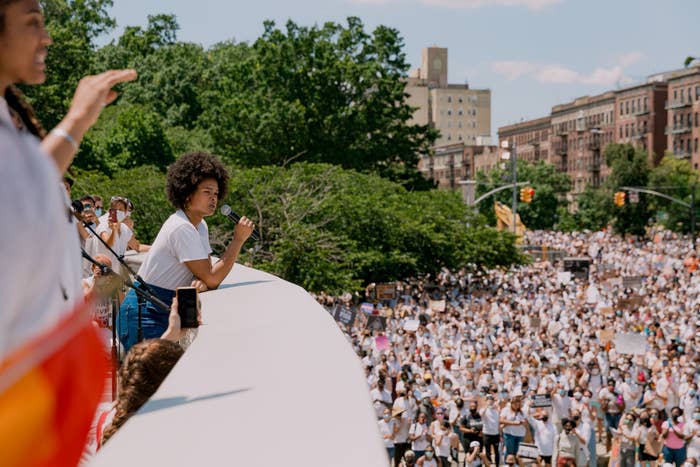
I knew the demonstration was going to be big as soon as I stepped out onto my stoop Sunday afternoon. Half a block away, an army of white-clad bikers were streaming southward down Franklin Avenue, a busy thoroughfare in Brooklyn’s Crown Heights. When my roommates and I turned the corner, we joined fellow white-wearers heading toward Eastern Parkway by foot, some of them carrying cardboard signs, others with grocery carts piled with supplies. It was a gorgeous spring day, sunny with a slight breeze.
If you didn’t know that organizers had requested that attendees wear white for Brooklyn Liberation, an action for Black trans lives taking place that day, the sight might have been slightly disconcerting — as if Crown Heights had suddenly been taken over by hundreds of members of the Guilty Remnant, the postapocalyptic cult in HBO’s The Leftovers. But for those of us who did know, it was extraordinary: a visual representation of everyone in our little corner of the universe pledging solidarity with the LGBTQ community’s most marginalized. In a way, maybe we were our own kind of futuristic sect, committing to a new and better world.
At the rally itself, drone footage and cellphone video from fire escapes across the street from the Brooklyn Museum, where the event was being held, would reveal a truly staggering number of people in attendance. Estimates put the crowd at well over 15,000, potentially making it the largest-ever trans-focused, trans-led demonstration in US history. On the ground, I could sense the scale as soon as our own stream of white-wearers met the ocean. But at the same time, Brooklyn Liberation offered all the comforts and intimacy of a small queer community event: friends running into friends; exes avoiding exes; carers offering free food and water and sunscreen.
The tone was somber, as attendees honored the memories of Black trans women’s lives lost to violence — two, Riah Milton in Ohio and Dominique “Rem’Mie” Fells in Pennsylvania, were killed just this past week. And it was angry, on the heels of a Trump administration rollback of Obama-era healthcare protections for trans people. But it was also a site of communion, of joy — Black queer and trans joy, in particular — which feels especially significant given the racism and anti-trans bigotry that runs rampant during mainstream LGBTQ Pride events.
Brooklyn Liberation wasn’t a Pride event per se, but it did take place during what normally would have been Brooklyn Pride weekend, which moved online this year due to the coronavirus pandemic. Organizers were aware of the timing, and therefore tried to “channel the energy for what would have been Pride into an action that felt meaningful during this moment, that represents our core values as a team and a community,” West Dakota, a drag performer and co-organizer, told me afterward. She was the one who thought to encourage attendees to wear white, inspired by a 1917 NAACP silent protest in New York against anti-Black oppression. It was also a way to differentiate the event from the usual rainbow-explosion aesthetic that, to many, has come to represent the corporate pinkwashing of Pride. “What Pride has become, particularly in the last several years — it’s heavily corporatized, heavily policed, this facade of queer representation,” Dakota said. “I think we were really trying to break away from that.”
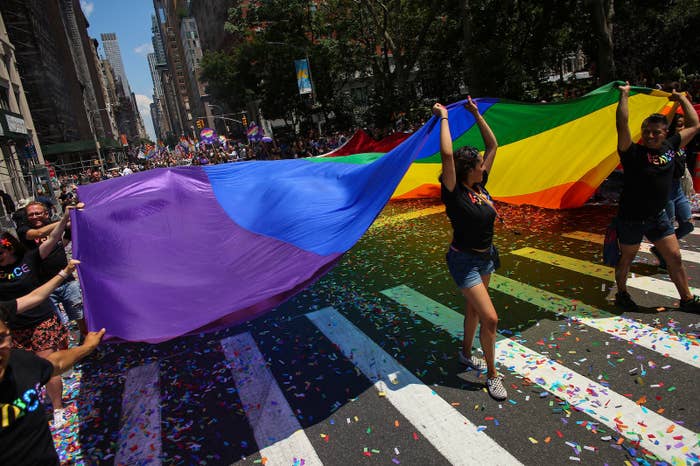
Official, government-sanctioned Pride events in cities and towns across the country have ballooned over the last decade, often to the frustration and protest of activists who are sick of the corporate sponsorship and heavy police participation in a movement born of a radical uprising against state violence. Official Pride organizers post-2016 had to cater to a new wave of #resistance fighters radicalized at last by Trump’s election — but most of those organizers didn’t take the opportunity to radically reconsider the role of Pride events during a time when white, wealthy, cisgender gay people have more power and cultural influence than ever before, while Black trans women, working-class queers, sex workers, and others on the margins are still struggling daily to survive.
Some cities in the past few years rebranded their Pride celebrations as “Resist” events, or added “Equality” marches to otherwise business-as-usual Pride weekends, which mostly accomplished the dubious goal of making anti-LGBTQ bigotry seem like a Trump-related problem, rather than a larger, long-term systemic problem. (Remember all those cringey “If Hillary had won, we’d be at brunch right now” signs?) Activist collectives like the Reclaim Pride Coalition in New York and No Justice No Pride in Washington, DC, have organized alternative events with “no cops, no corps, no BS.” (On June 28, Reclaim Pride will be hosting the Queer Liberation March for Black Lives and Against Police Brutality.)
Last year, to mark the 50th anniversary of the Stonewall riots, New York hosted WorldPride for the first time, attracting millions of people for what would become the largest LGBTQ event in modern memory. That weekend, while festivities raged in Manhattan, my girlfriend and I (along with pretty much everyone else I know) instead sought refuge and community at the historically queer People’s Beach at Jacob Riis Park in Brooklyn. An exhaustive 12-hour parade featuring banks and Fortune 500 companies, all of which paid thousands of dollars for the privilege of looking gay-friendly, wasn’t our idea of a good time. In fact, it felt actively insulting to the memory of the queer and trans people of color who fought for their rights 50 years ago, and to the work of those still fighting for the same rights today. Until Monday’s historic Supreme Court ruling, which forbids employers from firing someone for being queer or transgender, much of the United States did not have protections for LGBTQ workers in place. (Though all workers, LGBTQ or not, are still vulnerable thanks to “alarming gaps in federal civil rights laws” and employment at-will doctrines.) That was this week!
“Trans women are hunted like beasts in this world and nobody’s doing anything about it.”
2020 is very different from past years. The coronavirus pandemic has forced official Pride organizers worldwide to reimagine their celebrations in virtual spaces instead, including here in New York City. And rightly so: getting drunk and partying at sponsored parades or concerts or exclusive, stupidly expensive parties aren’t essential activities right now.
But what is essential, now and always, is protesting the anti-trans and anti-Black violence endemic to this country. Earlier this month, more than 1,200 public health experts signed a letter saying the protests against police brutality currently unfolding nationwide are “vital to the national public health and to the threatened health specifically of Black people in the United States.” As epidemiologists Julia Marcus and Gregg Gonsalves noted recently in the Atlantic, the decision to support those protests “reflects what public-health experts have always tried to do: maximize the health of the population across all aspects of life. And health is about more than simply remaining free of coronavirus infection.”
The spread of the coronavirus and resulting economic fallout have laid bare many facets of preexisting inequalities in this country; the epidemic of violence against trans women of color, particularly Black trans women, is just one of them. Overpolicing and mass incarceration, targets of this year’s mass protests, are also fundamentally LGBTQ issues. And as the inimitable Angela Davis recently put it, trans and nonbinary people living in their truths have offered our society a road map to police and prison abolition, because they’ve “taught us that it is possible to effectively challenge that which is considered the very foundation of our sense of normalcy.”
For activists and organizers who have been doing this work for decades now, Brooklyn Liberation’s action for Black Trans Lives and its historic turnout feels like a possible turning point, not only for Pride but for the entire LGBTQ movement. By channeling our elders and remembering our radical roots, we can make clear that gay assimilation and “equality” is not, and has never been, enough. What we demand instead is liberation.
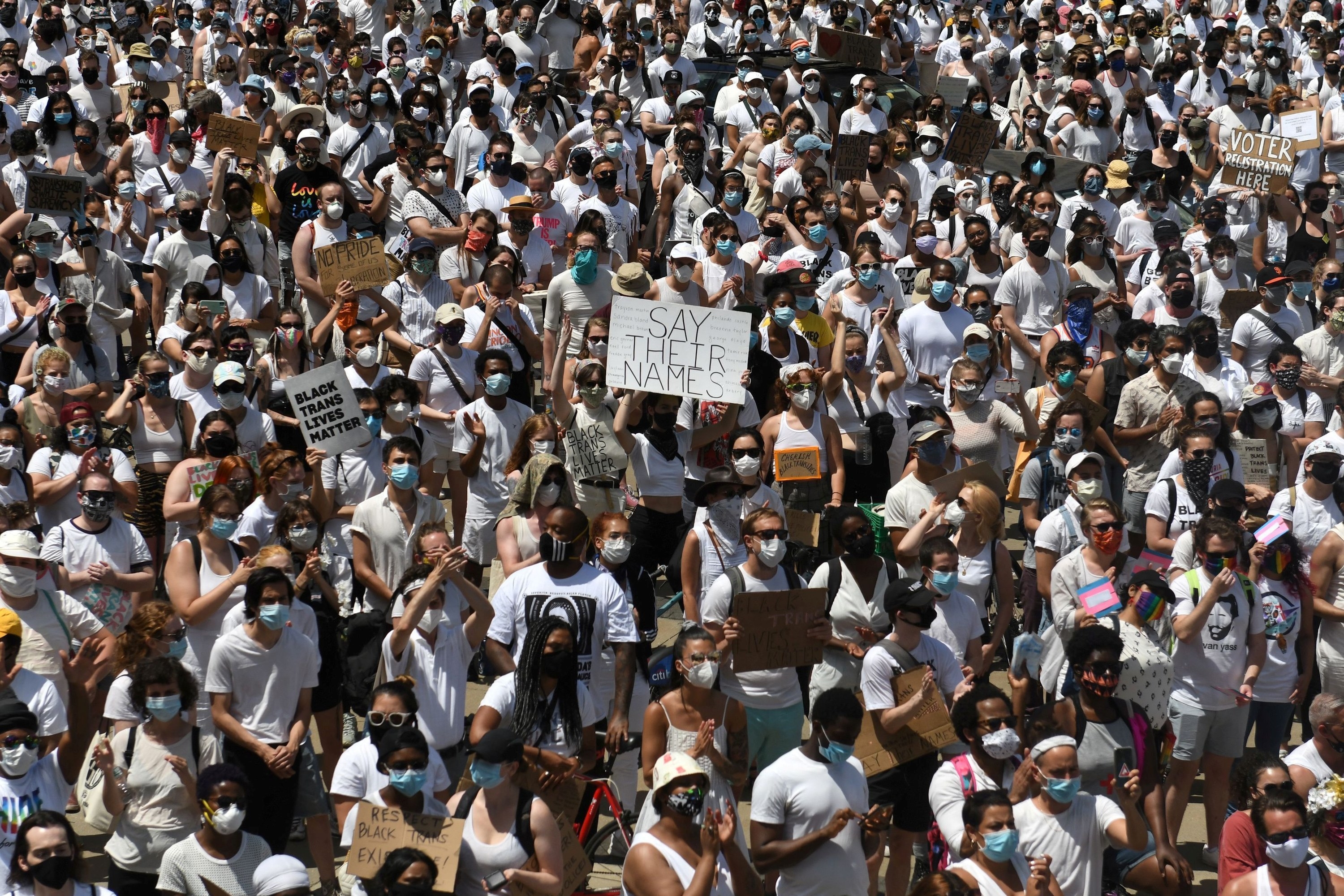
Ceyenne Doroshow — lovingly referred to as one of those elders by the younger crew of Brooklyn Liberation organizers — had never seen anything quite like the Brooklyn Liberation March in her many years of organizing on behalf of trans people and sex workers. As the founder and executive director of GLITS (Gays and Lesbians Living in a Transgender Society), which just raised over a million dollars to house Black trans people in New York City, Doroshow is dedicated to meeting trans sex workers’ immediate material needs.
“Trans women are hunted like beasts in this world and nobody’s doing anything about it,” she told me. “We deserve housing. Not a room or a box. We deserve adequate and sufficient sustainable housing. Not much to ask for when so many others have it. Why must we live like animals?”
Initially Doroshow hadn’t even planned to speak at the rally; she parked herself in a quiet corner and was going to ride out the event there. But the organizers begged her: “Please, please, we want you to look at this,” she said.
Fran Tirado, a writer, podcaster, and LGBTQ strategist who co-organized the event, teared up when recalling the efforts to shepherd Doroshow in front of the crowd. “We wanted to treat Ceyenne as the queen she is,” he said. “She was camping out at the bottom, but she’s our elder — she’s everything that we fight for! — so we needed to get her up here.” Action marshals were able to safely escort Doroshow to the elevated walkway wrapping around the front of the Brooklyn Museum, where speakers were presenting.
“She’s not here with us no more, but if she touches many more lives then she will live on forever.”
When she got there, Doroshow said, emphasizing every word, “It. Brought. Me. To. Tears.” She’d expected a small crowd, and instead found herself presiding over thousands. “When I walked up to the ledge, the crowd went crazy. It brought me to tears, to see so many of us in this sea of white people, so many beautiful Black and trans men and women. It just captured my heart. It was unfathomable — some of us had to die for this to happen.” She praised the young organizers who’d intentionally brought Black trans people to the front of the crowd and centered the voices of Black trans speakers, so that “people in New York City and around the world know that Black trans lives matter. I was shaking.”
You wouldn’t know any of that watching Doroshow address the crowd — she was just as captivating as every speaker with whom she shared the stage. One of them was Melania Brown, whose sister, Layleen Polanco, died last year in solitary confinement at Rikers, where she was being held on $500 bail. Newly released footage revealed that guards didn’t go into Polanco’s cell to check on her for over an hour and a half while she was dying of an epileptic seizure. “When one goes down we all go down, and I’m not going anywhere,” she said. “You’re not going to kill my sister and get away with it. I am coming for Rikers.”
“It was amazing,” Brown told me afterward. “I don’t even have words for it. I was overwhelmed with joy and love, seeing everybody come together, to fight for themselves and for others — that means a lot. It was purely magical. I felt her with me every step of the way. I will carry it with me for the rest of my life and cherish it forever. I hope we can continue to come together like this. It will make a difference. Things will change.” The first thing she hopes will go? The “walking while trans” loitering law that criminalized her sister. “She’s not here with us no more, but if she touches many more lives then she will live on forever.”
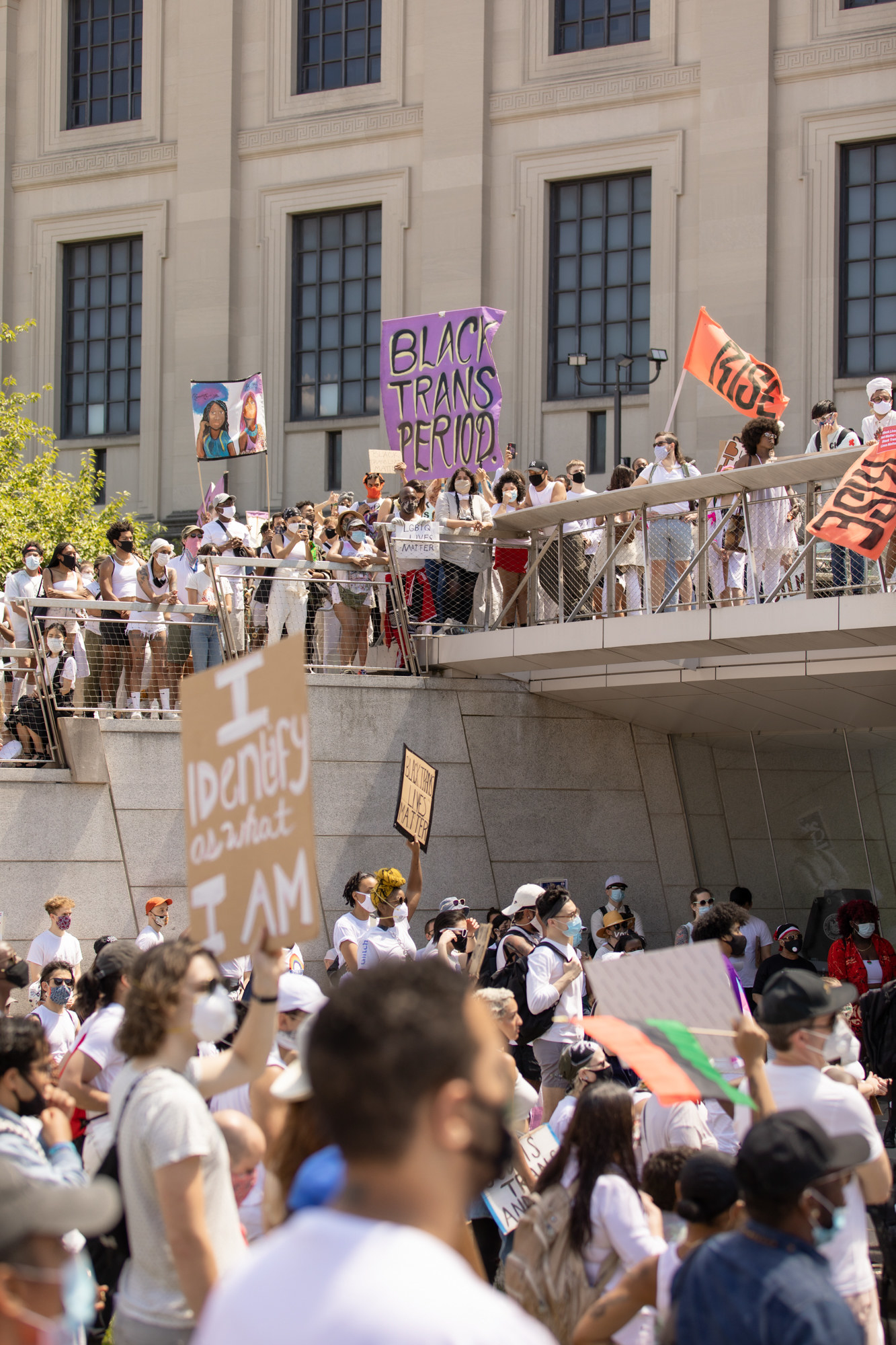
Eliel Cruz, the director of communications at the Anti-Violence Project, and another co-organizer of Brooklyn Liberation, told me that Brown’s speech was his most emotional moment of the day. Last year, after Polanco died, he organized what at that point had been the largest demonstration of his career, which drew about 600 to 700 people. Now, he watched Brown address a crowd of thousands. “It’s been really incredible to see this family grow,” he said, tearing up. “It’s not the case many times that families are such fierce advocates for their loved ones. It was such a beautiful moment, to see that happen — how much love she has for Layleen.”
Another speaker, the writer, editor, and activist Raquel Willis, who was rocking an Afro reminiscent of a young Angela Davis, made clear that legal battles are important, but “white queer folk get to worry about legislation while Black queer folk are worrying about our lives.” She led the crowd in a gorgeous, mesmerizing chant: “I believe in your power. I believe in our power. I believe in Black trans power.”
“For years — decades — Black and brown folks, trans and gender-nonconforming folks, have been calling for a restoration of that kind of radical fight against systems of oppression,” Raquel told me afterward. She thinks that Pride as we know it has now been ”forced to be transformed into something that really looks at the dynamics plaguing the most marginalized in our community.”
Once the speakers wrapped up, Black and trans people were escorted to the front of the march, and we all began to walk west on Eastern Parkway. There was some police presence at the rally, including a chopper threatening to drown out the speakers overhead, but overall I saw relatively few officers throughout the day — especially compared to New York City protests during Mayor Bill ee Blasio’s ill-advised curfew earlier this month, when police were gassing, assaulting, and arresting protesters and press alike.
West Dakota first thought of putting together a Black trans action, barely 10 days before it took place, after talking with her drag mother, Merrie Cherry, who felt unsafe physically joining most groups of protesters as a Black person. Dakota reached out to Cruz and Tirado, who decided from the jump not to collaborate with police on the event. (Organizers emphasized that the event was a group effort, led by queer people of color defering to Black leadership. The team also included Peyton Dix, Mohammed Fayez, Willie Norris, and Nicholas Valit Andersen.) “We were not going to request a permit,” Tirado said. “We were building our own system. It would be a betrayal of our movement to do otherwise.”
The organizers also hadn’t released the march route ahead of time, so they could avoid preemptive police shutdowns. Their security team monitored police scanners all day to make sure the march would proceed safely and unimpeded — and it did. The march was peaceful, vibrant, and full of life. Leadership collaborated with groups like the Okra Project, a collective founded by Ianne Fields Stewart (the event’s first speaker, as well as a producer and consultant), which pays Black trans chefs to provide free food to their communities; they did so that day throughout the action. A team of medics and marshals, overseen by Kalaya'an Mendoza, a nonviolent direct action facilitator, provided marchers with water, medicine, hand sanitizer, sunscreen, masks, and phone chargers, among other services. I passed a medic tent at one point where someone on a megaphone announced, “We’ve got a real Bernie Sanders wet dream over here.” Many attendees also showed up with extra supplies to distribute so that no one would have to go without.
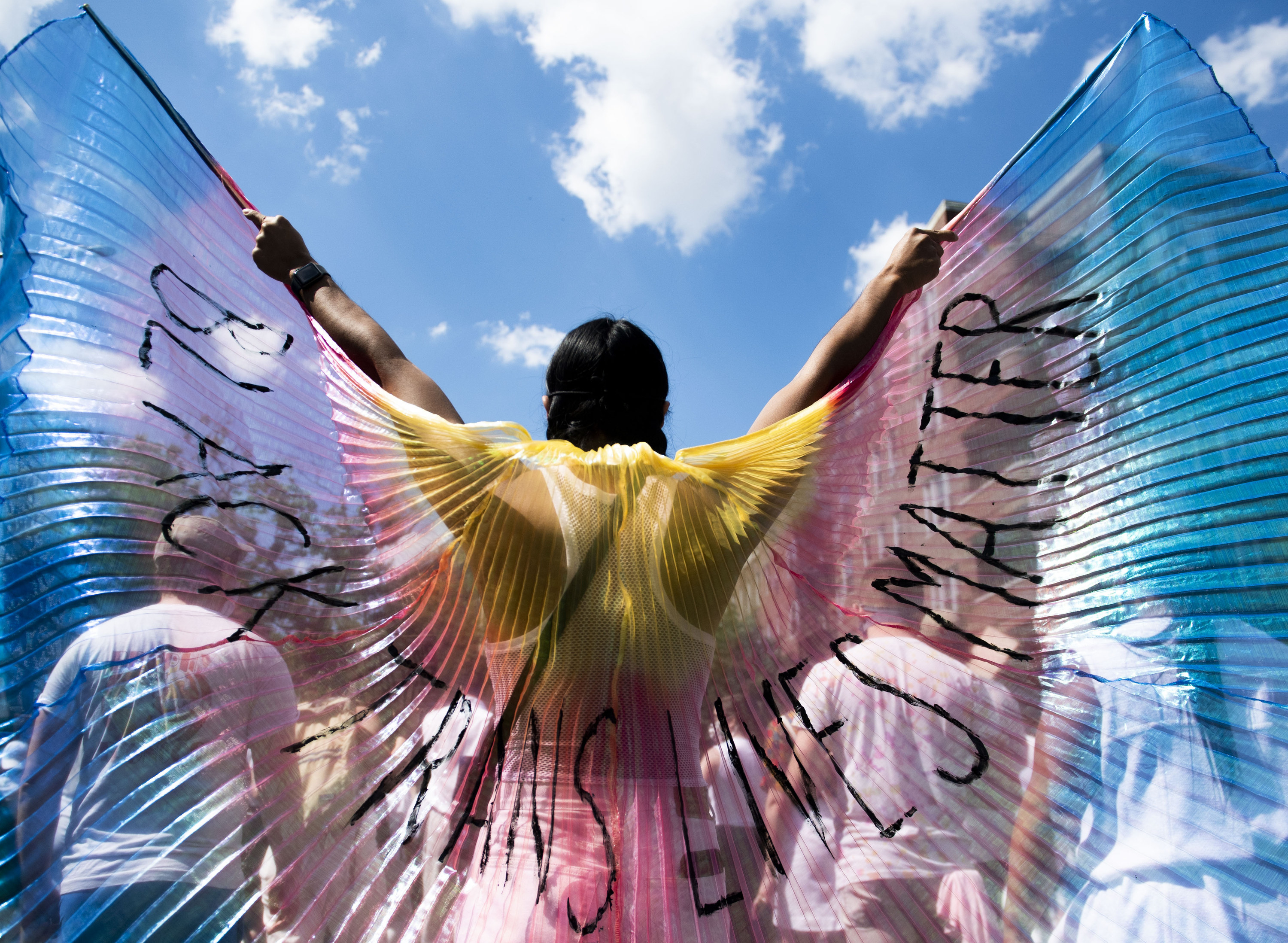
Cornel West has said that “justice is what love looks like in public.” Marching past the Brooklyn Public Library and down Vanderbilt Avenue, we saw old ladies wave to the marchers from their stoops. Kids toted hand-drawn signs and blocks upon blocks of cars stalled by the pedestrian traffic honked in unbothered solidarity, including the bus and truck drivers who’ve kept our city running during this pandemic. I’ll risk corniness and say I think this is what love looks like.
But it’s also long, long overdue. “I’ve been doing this shit by myself for the longest,” `Doroshow said. “Because, sweetie, if they didn’t give me the money I needed, I still had to do the work.” She recalled feeling alienated by Pride events in past years; once, she was on her way to join up with a Caribbean Equality float, but “I never made it to my destination. I had a full meltdown because of the policing of it, the surveillance, the corporatization — every aspect overwhelmed me,” she said. “The reality is, now [Pride organizers] are ready to do certain things with Black trans women ... they want us to promote Pride, dance for Pride, sing for it. But we’ve been here forever, sweetie. We don’t need you for Pride. We walk in Pride, we live in Pride.”
“We don’t need you for Pride. We walk in Pride, we live in Pride.”
The activist Sylvia Rivera, now hailed as a trans rights icon and community foremother for her work helping homeless LGBTQ youth, was marginalized by the mainstream gay rights movement she helped pioneer right up until her death in 2002. Quoted in the caption of a photo of the rally posted to the Instagram account @lgbt_history, Rivera lamented in 2001 that “everybody and their mother” came out to mourn the murder of Matthew Shepard, a gay white college student, in 1999. But when Amanda Milan, a Black trans woman, was killed shortly afterward, “we waited a month to have a vigil for her. Three hundred people showed up. We’re part of the gay and lesbian community!” Riviera said. “We’re capable of doing it on our own because that’s what we’re learning now, that we cannot depend on nobody except our own trans community to keep pushing forward.”
This event was something else entirely. “Walking through the crowd,” Doroshow remembered, choking up, “it broke my heart. It was precious to see everybody, old and young, saying, ‘I love you, Ceyenne, we love you, we support your work, we support Black trans lives.’ They stand with us, knowing we have lost so many.”
“We tapped into a deep ancestral knowledge — that wisdom and energy,” Willis said. “And I’m so thankful for the leadership of my ally siblings, West Dakota, and Fran and Eliel, folks who moved in and said, ‘Hey, we have privilege, we have access, we have platforms, we can build a vessel to catapult the most marginalized in our community into part of a larger conversation. They are — as much as Black trans folks are the leaders we’ve been waiting for — the allyship we’ve been waiting for.”
“People think, I need to be on the street, I need to show up, but there’s so many other things that can be done to facilitate mass movements,” Willis said. “This was a beautiful example of the little bit we can all bite off to tackle all the things plaguing our community. Hopefully this will be a model of what is possible when we allow organizing to be more expansive instead of exclusionary.”
The march made its way unimpeded to Fort Greene park, where its grassy green expanses turned into fields of white. There, marchers flopped down to rest, helping themselves to free food and water, talking and laughing and chanting and singing together. Show me what community looks like; this is what community looks like. Who keeps us safe? We keep us safe.
“Seeing Black queer and trans joy was really so moving,” West Dakota told me. “Especially after this week, with a lot of very heavy events that have occurred” — the Trump trans healthcare rollbacks, which were thankfully nullified by the Supreme Court ruling; more reports of trans death. “But in this larger context, Black queer and trans folks had a moment to feel their power.”
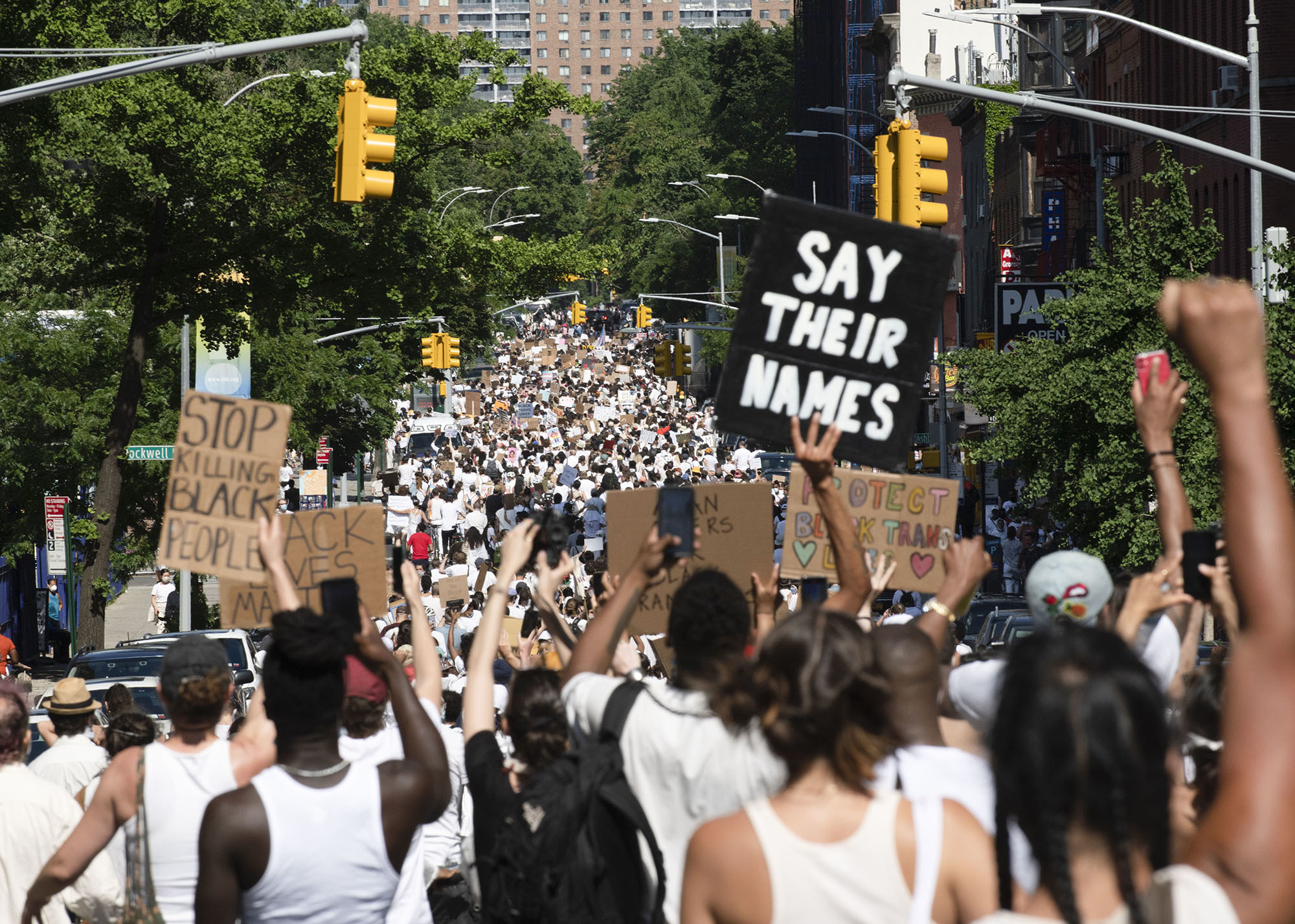
I was moved in much the same way. Toward the demonstration’s end, when most of the marchers had flooded into the park or started to make their way home, a group of mostly Black queer and trans people opened up a dance circle in the middle of the street, while onlookers cheered and laughed. It was one of many moments throughout the day that made me cry, that filled me with joy and with hope. It’s important to remember, as Imani Perry recently wrote in the Atlantic, that Black people “are still, even in our most anguished seasons, not reducible to the fact of our grief. Rather, the capacity to access joy is a testament to the grace of living as a protest.”
“It felt collective,” Willis said. “Black trans experience is so interior and so isolated, but [the march] was just such a display of how it doesn’t have to be that way anymore. We can feel connected and bound up in each other’s liberation.”
The hope now is that newly radicalized allies don’t abandon the cause as soon as it’s no longer centered in the national news. Queer and trans people of color have been doing this work for a long, long time, without sufficient resources or recognition or broader LGBTQ support, but it’s hard to imagine this momentum dying down. So many people who witnessed history in the making on Sunday agreed: This is what real Pride looks like, what Pride should always be.
“If you didn't hear our voices before, sweetie,” Doroshow said, “just look what we did to Grand Army Plaza.” ●
